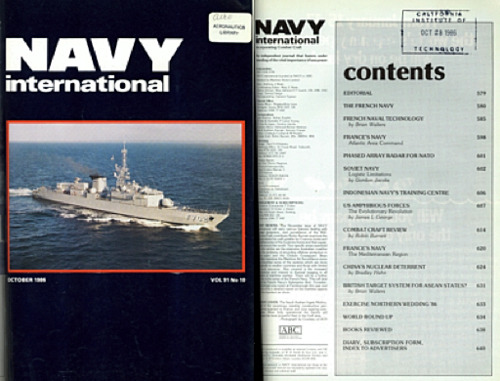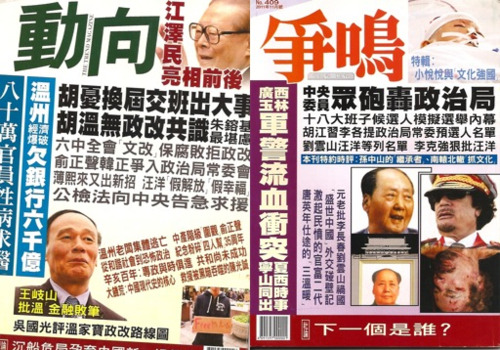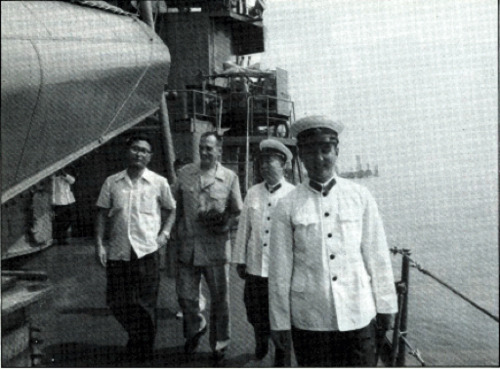For several months now, I have been researching the origin of the very high estimates of Chinese warheads presented recently by Georgetown professor Phillip Karber—a search that has taken me to Hong Kong and the Caltech library. Based on that, here is what I believe the story is. I am continuing to track down the details.
As noted in previous posts, Prof. Karber has raised the possibility that China has several thousand nuclear weapons, in stark contrast to current governmental and non-governmental estimates of at most a couple hundred. The sources of the numbers he quotes are not authoritative—they are questions raised by Chinese bloggers about numbers they saw on the web. Dr. Karber did not find the original source that the bloggers were quoting, but the implication is that the numbers came from secret Chinese sources and are therefore credible.
I traveled to Hong Kong and found the source of the numbers the bloggers were questioning, which was a 1995 article in a magazine called The Trend, published by a group of anti-Communist Chinese in Hong Kong. But what my further research shows is that the numbers in The Trend article appear to come from a 1986 article published in the British journal Navy International by a US military officer named Bradley Hahn, which presents very similar numbers.
Based on my research, here is what appears to have happened. Following an August 1995 Chinese nuclear test, a Chinese author wrote an article about China’s nuclear arsenal, which was published by The Trend’s sister publication, Zhengming; the two magazines are published out of the same office. In it, this author quotes a range of estimates for the number of nuclear weapons China has, including western estimates of several hundred weapons. He also appears to borrow heavily from Hahn’s article, giving higher estimates that are surprisingly similar to those in the 1986 paper.
Two weeks later, the article in The Trend appears—written by a person or a group of people under the pseudonym “Counter Left”—that hews closely to Hahn’s article but appears to have tried to update Hahn’s 1986 estimates to 1995 estimates.
This suggests that the original source of the numbers Prof. Karber is citing are not secret Chinese statements but instead statements by a US author that were picked up by a Chinese author and then used by someone writing under a pseudonym to suggest a very aggressive Chinese nuclear buildup. While Hahn attributes some of his information to Chinese sources, much of the information he presents in his 1986 article is now known to be wrong, so it can’t be considered an authoritative source.
Chasing down important details like this takes time and effort, but the details matter.
********
With that summary, here is a longer account.
Navy International (not to be confused with Jane’s Navy International) is an old UK publication with a short history that printed its last issue in 1994. Not many libraries have it in their stacks, but I found it at Caltech. I wanted to look through Navy International because one of the Chinese blog posts listed on Dr. Karber’s slide from his presentation in Georgetown on September 26 contained the following reference:
Bradley Hahn’s article “China’s Nuclear Deterrent,” published in the British journal Navy International, said, “Chinese production of nuclear warheads for bombs and missiles reached 200 by 1970, passed 500 by 1976, and was well over 700 units of all sizes in 1979. An estimate based on an average annual production of 70 warheads is approximately 875 by the beginning of 1981. … China already produced (to 1986) about 1,230 nuclear warheads.
Continuing to quote Hahn’s article the blogger writes:
A report estimates Chinese nuclear weapons are divided in the percentages: nuclear bombs 44%, strategic missiles about 34%, tactical missiles about 20% nuclear mines about 2%.

I found Bradley Hahn’s original article in the October 1986 issue of Navy International. The quotes in the Chinese blogger’s post, cited on Karber’s slide from his September 26 report, can be found on page 625 of Hahn’s article, which is titled “China’s Nuclear Deterrent.” The Chinese blogger takes some liberties with the phrasing, but the quantitative information is identical.
The percentages in the Hahn article are almost identical to the percentages in the September 1995 article in the Hong Kong magazine The Trend, which is cited by one of the other Chinese bloggers listed on Dr. Karber’s slide as the source of his “Chinese statements” on nuclear warheads. Here is the relevant passage from the article in The Trend:
In the CCP [Chinese Communist Party] nuclear arsenal, 40% are nuclear bombs, 34% are strategic nuclear missiles, 25% are tactical nuclear missiles, 1% are nuclear mines.
There are other passages in The Trend that closely resemble passages in Hahn’s October 1986 article—for example, their respective statements on air-delivered nuclear weapons. The Trend writes:
The Special Air Forces (the nuclear weapons carrying Air Corps of the Air Force) at present have two special division under the joint command of the Air Force and the Second Artillery possess the following (usable aircraft): 150 Hong-6D medium range twin jet-powered aircraft, 20 Hong-7 aircraft, 250 Qiang 5 M aircraft and 50 Jian-8 II aircraft.
Hahn, nine years earlier, writes;
There are three types of operational aircraft capable of nuclear weapons delivery by elements of the PLA Navy and Air Forces. These include about 120 Hong-6 medium range twin-jet bombers, 250 Qiang 5 ground support twin-jet tactical ground support fighter-bombers and 30 new Jian 8 twin-jet aircraft…
I am posting a copy of Hahn’s article and a full translation of The Trend article for those who would like to explore the similarities between these two texts.
But there is another connection between the 1986 Hahn article and the 1995 article in the The Trend, which is less direct but also worth noting.
The Trend, whose romanized Chinese name is Dongxiang, is the sister publication of a better known Hong Kong magazine called Zhengming. Both are published out of the same office by the same staff. They have the same contact address and phone number in Hong Kong. Dongxiang is published on the fifteenth of each month, while Zhengming is published on the first of each month.
The magazines are very well known for their strong negative views of the Chinese Communist Party and for publishing sensational stories on Chinese internal politics. The picture below shows recent covers of Zhengming (left) and its sister publication The Trend (Dongxiang). The caption under the picture of Khadafi and Mao reads “Who’s Next?”

The reputation of the magazines has waxed and waned over the years but they have thrived in the highly competitive world of Hong Kong commercial publishing. Some consider them an important source of inside information on Chinese politics. But others, including a wise, experienced, and well-known Chinese scholar who remained in the United States after the Tiananmen Massacre, describe the magazines this way:
I would not trust sources like Dongxiang since they are viewed as no more than gossip outlets. Because I find Dongxiang and Zhengming not very credible sources, I stopped reading them long time ago and have not used them as sources ever. So I suggest you should not bother, either.
– email communication with that well-known Chinese scholar
I looked through many years of the tables of contents of both magazines during my week at the Hong Kong Central Library. Neither magazine is known for expertise on Chinese nuclear weapons or Chinese military issues, so, not surprisingly, there were only a handful of articles on nuclear weapons issues published during the 34 years since Zhengming printed its first edition in 1977.
As the translation makes clear, the September 1995 article in The Trend was written on the occasion of a Chinese nuclear test that took place the month before. Since it was published on the 15th of September, and since the nuclear test was getting a lot of international press attention because of both the negotiations on the Comprehensive Nuclear Test Ban Treaty and the 1995 Taiwan Strait Crisis, I thought perhaps that Zhengming might have also decided to cover the nuclear test story in its September 1995 edition, published two weeks earlier on the first of the month. It did. And here is a section of its story discussing the size of China’s nuclear arsenal.
In 1970 they (the CCP) had about 50 warheads, by 1975 300 warheads, by 1980 they already had more than 700 warheads, and by 1985 an estimated 1,245 warheads.
These are very similar to the numbers listed above from the Hahn article. In addition, even though this article was published in 1995, the authors stop counting in 1985, and they stop with a count that is almost the same as Hahn’s final count when he published his article in 1986.
There are different possible explanations for the similarities between Hahn’s accounts of China’s nuclear arsenal and the details on numbers published in these two Hong Kong magazines. One possible explanation is that the authors of these articles were using Hahn’s account as a resource, just like the Chinese blogger cited on the bottom of Dr. Karber’s slide from September 26 of this year.
If that is the case, the numbers being discussed by Dr. Karber in his slides, which are based on the information in the September 1995 article in The Trend, may not have come from a leaked Chinese Ministry of Defense document from 1995, as the Chinese authors of that article claim, but from the article published by Bradley Hahn in Navy International nine years earlier.

Bradley Hahn (pictured above, second from left) spent a considerable amount of time in China during the early-mid 1980s as an officer in the US Navy. At the time the Reagan administration, in which Dr. Karber served, was working with China to contain the Soviet Union.
Hong Kong was an especially important door to travel in and out of the mainland in the early 1980s. Many people, like me, had to travel through Hong Kong on their way to and from the United States. Given his naval ties, and the importance of what was then the British port of Hong Kong, Hahn most likely spent some time there. It is even possible that he knew, or was known by, the editors of The Trend.
I am working with the current editors of the two Hong Kong magazines to try to learn more about this story, and I will pass along any new information. But I think the bulk of my work on the serious problems with Dr. Karber’s claims about the size of China’s nuclear arsenal is done. To sum up, here is what we know:
- The Chinese “sources” cited by Dr. Karber are not authoritative and do not make the statements he says they make.
- These sources copied the information that Dr. Karber is citing in his reports from an article in the September 1995 issue of a Hong Kong magazine called The Trend.
- The author of that article uses a pseudonym, “Counter Left.”
- Some of the data in that article appears to have been lifted from a 1986 article on Chinese nuclear forces published in a relatively unknown UK publication called Navy International written by a young US Naval officer named Bradley Hahn.
- Other data from Hahn’s article may have been used in an article on China’s nuclear forces published two weeks earlier in Zhengming, a sister publication of The Trend.
- The credibility of both Zhengming and The Trend is questionable, and neither magazine is known for its expertise on Chinese military or nuclear issues.
- Many of the technical details about China’s nuclear forces contained in both the 1986 Hahn article and the 1995 article in The Trend are known to be in error.
This last point has been covered extensively elsewhere. I suspect there will be many more articles and blog posts that examine the technical errors contained in the claims made by Hahn in 1986, The Trend in 1995, and Dr. Karber in 2011.
Although I have my doubts, hopefully we will not have to revisit these highly questionable old claims about the size of China’s nuclear arsenal again. But if we do, I hope this information will be used to examine the historical connections between these dubious claims.
The next post in this series can be found here.
